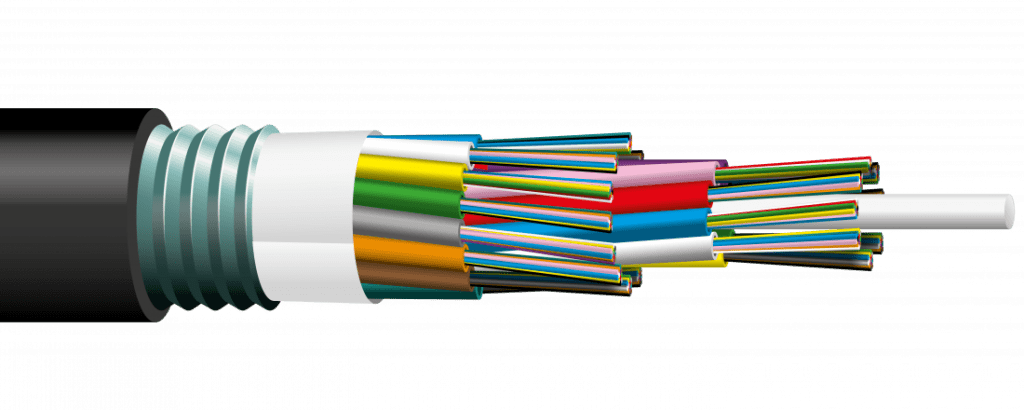When we speak into a landline telephone, a wire cable carries the sounds from our voice into a socket in the wall, where another cable takes it to the local telephone exchange. Mobile phones work a different way: they send and receive information using invisible radio waves. Fibre optics work a third way. It sends information coded in a beam of light down a glass or plastic pipe.
How Does A Fibre Optics Cable Work?
The light travels down a fibre-optic cable by repeatedly bouncing off the sides. Each tiny photon (particle of light) bounces down the pipe. Now you might expect a beam of light, traveling in a clear glass pipe, to leak out of the edges. But if the light hits the glass at a shallow angle (less than 42 degrees), it reflects in again – as though the glass were a mirror. This phenomenon is called total internal reflection. It’s one of the things that keeps light inside the pipe.

The other thing that keeps light in the pipe is the cable structure, which is made up of two separate parts. The central part of the cable is called the core, and that’s the bit where the light travels. Wrapped around the outside of the centre is another layer of glass called the cladding. The cladding’s job is to keep the light signals inside the core. It can do this because it is made of a different type of glass to the centre.
Different Types Of Fibre Optic Cables
There are three main types of fibre optic cables:
- Mode
Optical Fibres carry the light signals down what are called modes. It sounds technical, but it just means different traveling modes: a mode is simply the path that a light beam follows down the fibre. One mode is to go straight down the middle of the fibre. Another is to bounce down the fibre at a shallow angle. Other modes involve jumping down the fibre at different angles.
- Single-mode
The simplest type of optical fibre is called single-mode. It has a skinny core of about 5-10 microns (millionths of a meter) in diameter. In a single-mode fibre, all signals travel straight down the middle without bouncing off the edges. Single-mode fibres generally carry cable TV, internet, and telephone signals, wrapped together into a huge bundle. Cables like this can send information over 60 miles (100 km).
- Multi-mode
Another type of fibre-optic cable is called multi-mode. Each optical fibre is a multi-mode cable about ten times bigger than one in a single-mode cable. This means light beams can travel through the core in multiple different modes. Multi-mode cables can send information only over relatively short distances and are used, among other things, to link computer networks together.
How Are They Used For Computer Networks?
Fibre-optic cables are now the primary way of carrying information over long distances because they have three advantages over old-style copper cables:
- Less signal loss: Information travels roughly ten times further before it needs amplifying, making fibre networks more straightforward and cheaper to operate and maintain.
- No interference: Unlike with copper cables, there’s no “crosstalk” (electromagnetic interference) between optical fibres, so they transmit information more reliably with better signal quality
- Higher bandwidth: Fibre-optic cables can carry far more data than copper cables of the same diameter.
The faster people can access the Internet, the more they will do online. The arrival of broadband Internet made possible the phenomenon of cloud computing (where people store and process their data remotely, using online services instead of a home or business PC in their premises). In much the same way, the steady rollout of fibre broadband (typically 5–10 times faster than conventional DSL broadband, which uses ordinary telephone lines) will make it easier for people to do things like streaming movies online instead of watching broadcast TV or renting DVDs. With more fibre capacity and faster connections, we’ll be tracking and controlling more aspects of our lives online using the Internet.
The Internet is designed to transport any information for any use; it’s not limited to carrying computer data. While telephone lines once took the Internet, now the fibre-optic Internet takes telephone (and Skype) calls instead. Telephone calls were once routed down an intricate patchwork of copper cables and microwave links between cities. Most long-distance calls are now routed down fibre-optic lines. Vast quantities of fibre were laid from the 1980s onward; estimates vary wildly, but the worldwide total is believed to be several hundred million kilometres. In the mid-2000s, it was estimated that as much as 98% of this was unused “dark fibre”; today, although much more fibre is in use, it’s still generally believed that most networks contain anywhere from a third to a half-dark fibre.
Need data cabling experts near the London area? Our experts specialise in internet connections and are happy to answer any queries you may have. Call a member of our team on 0207 630 6094 or email us at hello@datacableinstallation.co.uk.